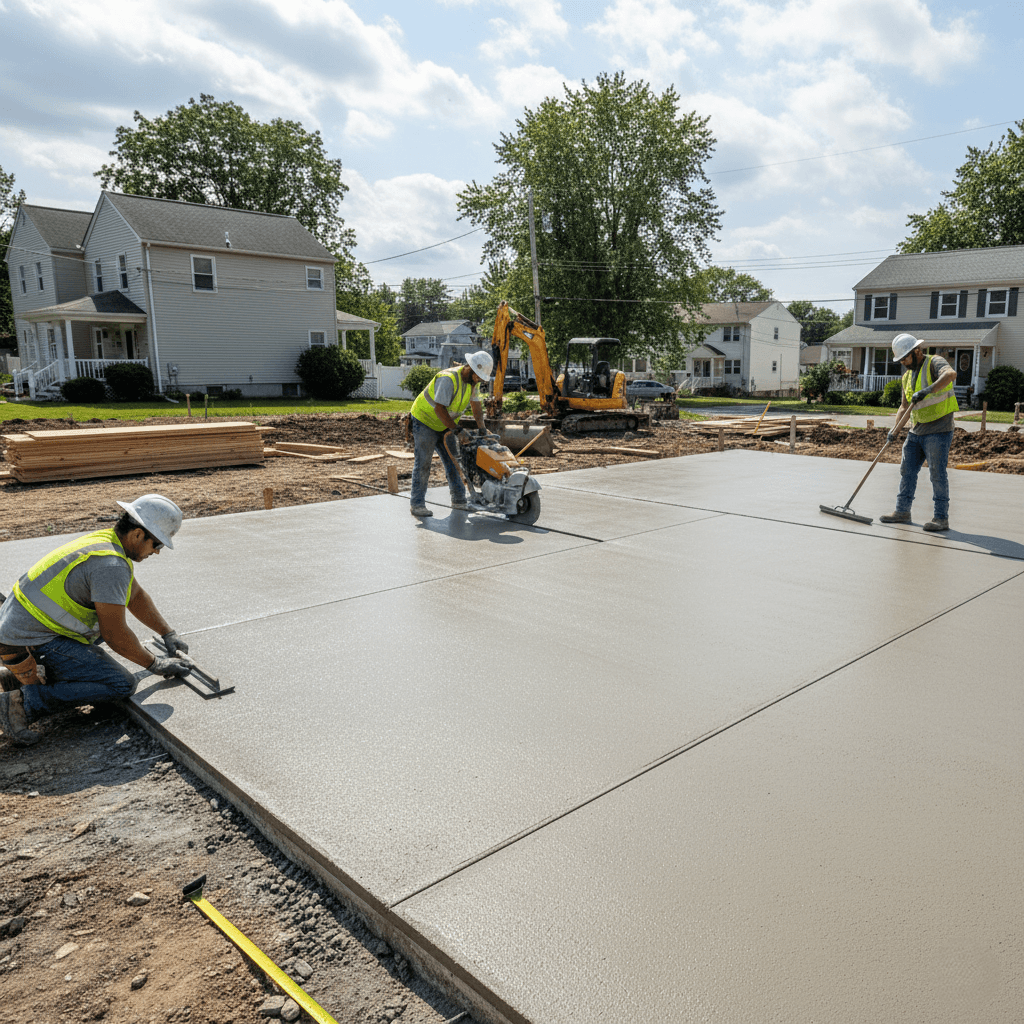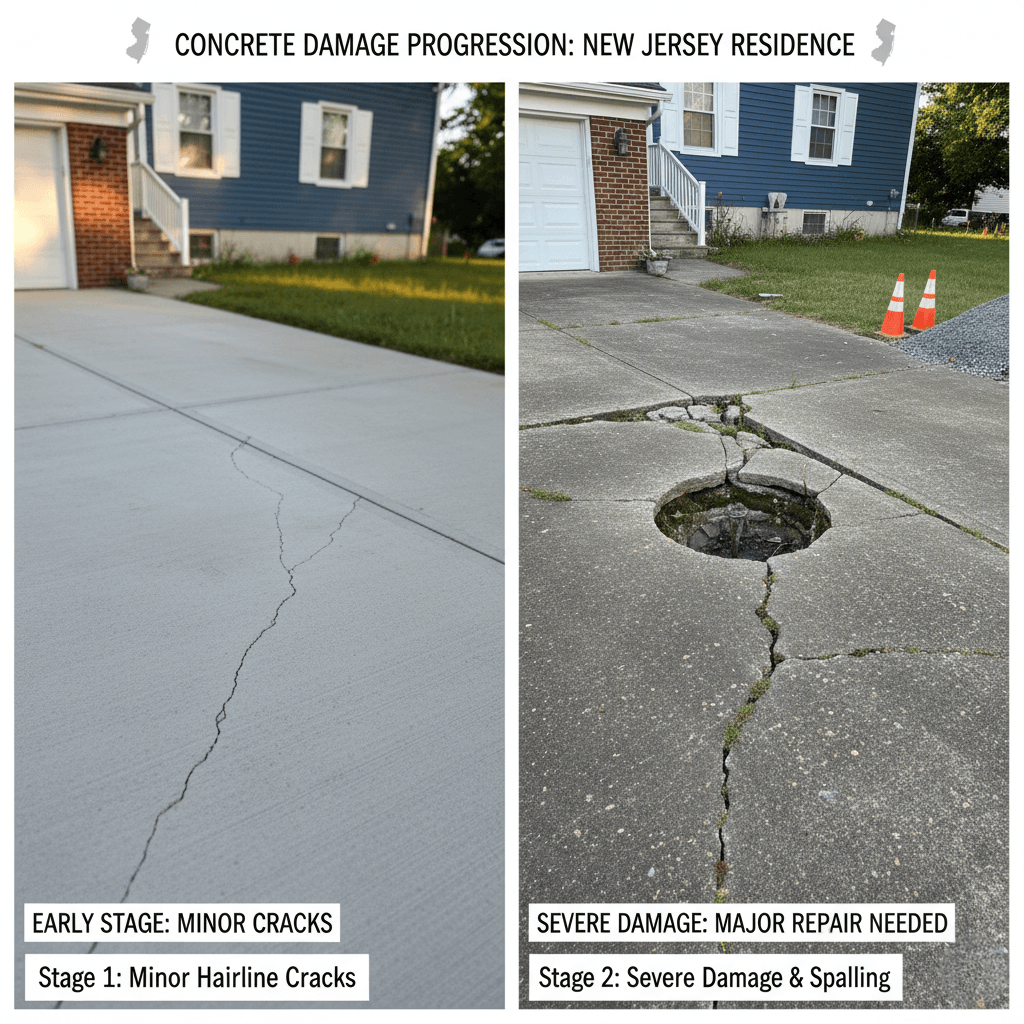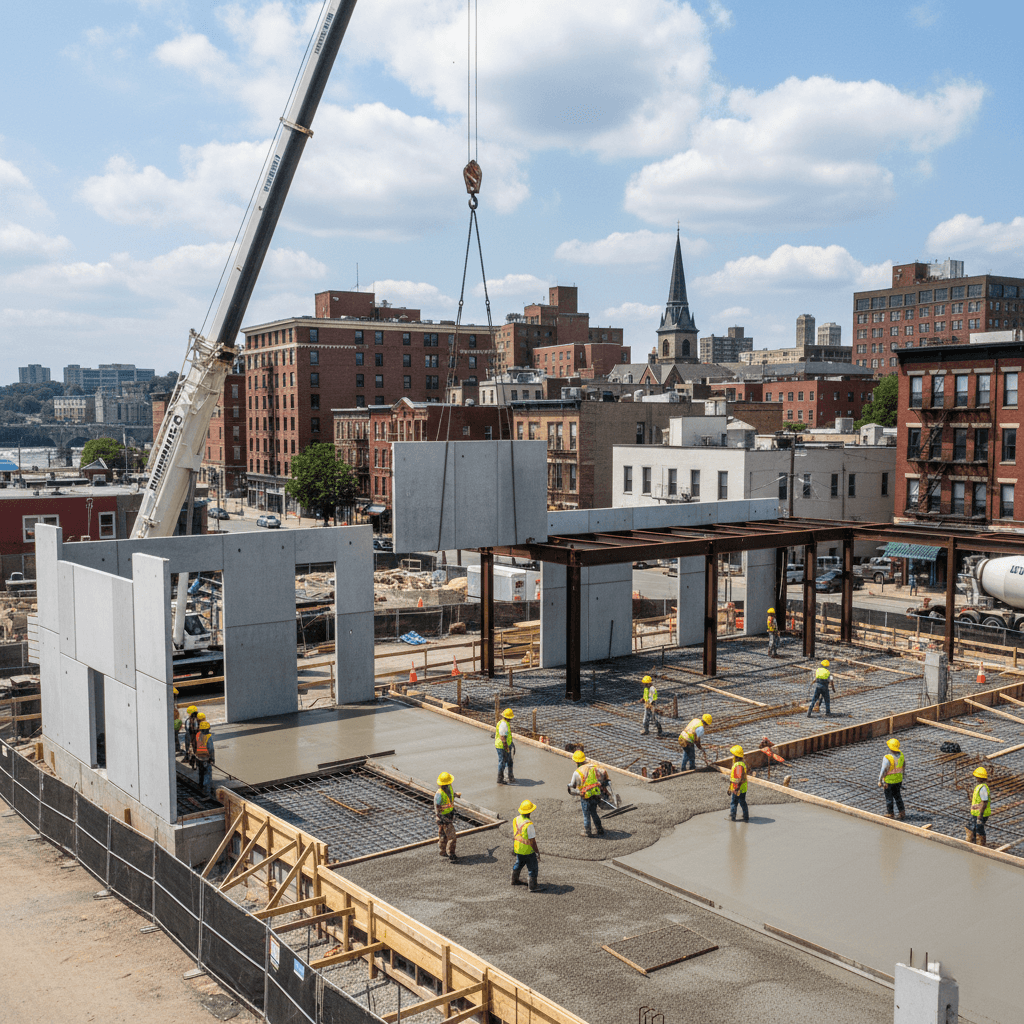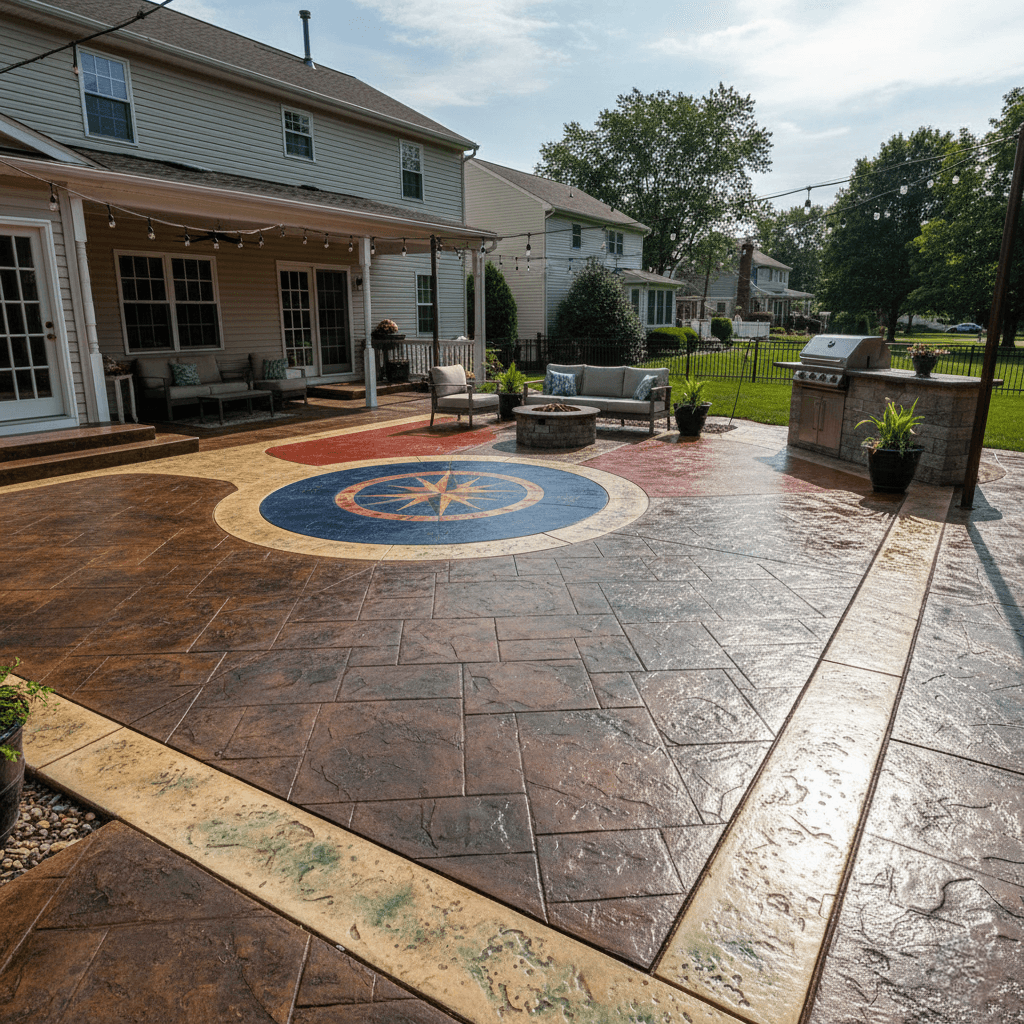
Concrete Repair Delays Can Be Expensive in Paterson
Concrete Repair Paterson
Delaying concrete repair in Paterson, NJ, creates a cascade of problems that multiply both damage severity and repair costs over time. What begins as minor surface cracking or small structural issues quickly escalates into major problems requiring extensive reconstruction rather than simple maintenance. Understanding how delayed concrete repair costs escalate helps property owners make informed decisions about timing and budget allocation for essential maintenance. Additionally, Paterson’s climate conditions, including freeze-thaw cycles, accelerate damage progression, making early intervention even more critical for long-term cost control. Moreover, proactive repair strategies protect property values while preventing safety hazards that could result in liability issues for homeowners and businesses.

The Progressive Nature of Concrete Damage
Concrete damage progression follows predictable patterns that worsen exponentially when left untreated, transforming minor maintenance issues into major structural problems. Small cracks allow water infiltration that leads to freeze-thaw damage, spalling, and eventual structural compromise requiring complete replacement. Additionally, surface scaling and minor imperfections provide entry points for moisture that accelerates deterioration throughout the entire concrete matrix. Professional assessment identifies early-stage damage when repairs remain cost-effective and minimally invasive. Furthermore, understanding damage progression helps property owners recognize when immediate action prevents future catastrophic failures and associated costs.
Water Infiltration and Freeze-Thaw Cycles
Water infiltration through cracks creates the foundation for accelerated damage in Paterson’s variable climate conditions. When temperatures drop below freezing, absorbed water expands by nine percent, creating internal pressures that enlarge existing cracks and create new ones. Moreover, each freeze-thaw cycle compounds previous damage, with cracks growing progressively larger and more extensive. Professional intervention during the early stages prevents this cycle from gaining momentum and causing irreversible structural damage. Additionally, sealed surfaces resist water penetration and significantly reduce freeze-thaw damage potential throughout the winter months.
Cost Escalation Timeline and Financial Impact
Repair cost escalation follows a steep upward trajectory as damage progresses from surface issues to structural problems requiring comprehensive solutions. Minor crack repairs costing $250-$800 can escalate to foundation replacement projects exceeding $20,000 when intervention is delayed. Additionally, secondary damage, including water infiltration, mold growth, and structural instability, multiplies repair complexity and associated costs. Professional contractors document how early intervention typically costs 70-80% less than delayed repairs, addressing advanced damage stages. Furthermore, insurance coverage often excludes damage resulting from deferred maintenance, leaving property owners responsible for full repair costs.
Compound Damage and Secondary Issues
Delayed repairs create compound damage affecting multiple building systems beyond the original concrete problem areas. Water infiltration leads to foundation issues, basement flooding, mold growth, and structural instability that require coordinated repairs across multiple trades. Moreover, compromised structural integrity affects adjacent concrete elements, creating widespread damage requiring comprehensive restoration rather than targeted fixes. Professional evaluation identifies these interconnected issues and develops comprehensive repair strategies that address root causes rather than symptoms. Additionally, early intervention prevents cascade failures that affect electrical systems, plumbing, and interior finishes throughout the property.
Safety and Liability Considerations
Delayed concrete repair creates significant safety hazards that expose property owners to liability risks and potential legal consequences. Cracked walkways, uneven surfaces, and unstable steps present trip hazards that can result in serious injuries and costly lawsuits. Additionally, structural instability from deferred foundation repairs compromises building safety and may violate local building codes requiring immediate attention. Professional documentation of safety hazards provides legal protection while establishing timelines for necessary repairs. Furthermore, prompt repair demonstrates reasonable care and maintenance that supports favorable legal outcomes if accidents occur.
Code Compliance and Regulatory Issues
Building code violations resulting from delayed repairs can trigger enforcement actions, fines, and occupancy restrictions that significantly impact property use and value. Paterson’s building officials have the authority to condemn unsafe structures or require immediate repairs when structural integrity is compromised. Moreover, code violations must be disclosed during property sales, negatively affecting marketability and sale prices. Professional contractors ensure repairs meet current building codes and provide documentation supporting code compliance. Additionally, proactive maintenance prevents violations that could restrict property use or trigger expensive emergency repairs.
Property Value Protection and Market Impact
Deferred maintenance and visible concrete damage significantly reduce property values while limiting market appeal to potential buyers and tenants. Professional appraisers reduce property valuations when structural issues suggest ongoing maintenance problems or safety concerns. Additionally, damaged concrete creates negative first impressions that affect buyer interest and negotiating power during sales transactions. Early repair preserves property values while maintaining competitive positioning in local real estate markets. Furthermore, well-maintained properties command premium prices and attract quality tenants who appreciate professional property management.
Insurance and Financing Implications
Insurance companies may deny claims or cancel policies when damage results from deferred maintenance rather than sudden catastrophic events. Mortgage lenders require properties to meet safety and structural standards that delayed repairs often compromise. Moreover, home inspection reports highlighting deferred maintenance can derail sales transactions or require extensive negotiations. Professional maintenance documentation supports insurance claims and demonstrates responsible property stewardship to lenders and insurers. Additionally, preventive maintenance often qualifies for insurance discounts that offset repair costs over time.
Seasonal Timing and Weather Considerations
Paterson’s seasonal weather patterns create critical timing windows for concrete repairs that affect both success rates and long-term performance. Spring repairs allow complete curing before summer heat and winter freeze-thaw cycles stress new materials. Additionally, fall repairs protect against winter damage but require careful timing to ensure adequate curing before freezing temperatures. Professional contractors monitor weather forecasts and adjust repair schedules to optimize material performance and longevity. Furthermore, emergency repairs during winter months cost significantly more and may require temporary solutions until permanent repairs become feasible.
Emergency Repair Premiums and Availability
Emergency repairs during winter months or peak construction seasons typically cost 50-100% more than scheduled maintenance due to urgency premiums and limited contractor availability. Contractors charge premium rates for emergency services while material costs increase during high-demand periods. Moreover, emergency repairs often require temporary solutions that add to total project costs when permanent repairs are completed later. Professional scheduling during off-peak periods provides cost savings while ensuring adequate time for proper repairs. Additionally, planned maintenance prevents emergencies that disrupt property use and require expensive temporary accommodations.
Long-term Maintenance and Lifecycle Costs
Delayed repairs create ongoing maintenance burdens that require repeated interventions and increased lifecycle costs compared to timely professional repairs. Properly executed repairs provide 15-25 year service life, while delayed repairs often require repeated attention within 5-10 years. Additionally, deferred maintenance accelerates wear on adjacent systems and surfaces, creating widespread problems requiring comprehensive renovation. Professional repairs include warranty coverage that protects against premature failure and provides long-term value. Furthermore, quality repairs enhance property durability while reducing annual maintenance requirements and associated costs.
Preventive Maintenance Programs
Preventive maintenance programs identify and address minor issues before they become major problems requiring expensive repairs or replacement. Regular inspections and minor repairs typically cost 10-20% of reactive maintenance while providing superior long-term performance. Moreover, documented maintenance programs support warranty claims and insurance coverage while demonstrating responsible property stewardship. Professional contractors offer maintenance programs that include regular inspections, minor repairs, and preventive treatments. Additionally, preventive programs help property owners budget for maintenance while avoiding unexpected major repair expenses.
Technology and Diagnostic Advantages
Modern diagnostic technology allows early detection of concrete problems before they become visible or cause structural damage. Thermal imaging, ground-penetrating radar, and moisture detection equipment identify hidden issues that traditional inspections might miss. Additionally, early detection enables targeted repairs that address root causes rather than symptoms, providing better long-term outcomes. Professional contractors use advanced diagnostic tools to develop accurate repair specifications and cost estimates. Furthermore, technology-assisted inspections provide documentation supporting insurance claims and warranty coverage for professional repairs.
Quality Control and Monitoring Systems
Professional repair projects include quality control measures and monitoring systems that track performance and identify potential issues before they become problems. Digital documentation provides historical records supporting future maintenance decisions and warranty claims. Moreover, monitoring systems alert property owners to changing conditions that may require attention before damage occurs. Professional contractors provide ongoing support and monitoring services that extend repair life and optimize performance. Additionally, quality control documentation supports property sales and provides confidence to potential buyers about structural integrity.
Economic Benefits of Early Intervention
Early intervention provides substantial economic benefits through reduced repair costs, extended component life, and enhanced property values compared to delayed maintenance strategies. Professional studies demonstrate that every dollar spent on preventive maintenance saves $3-5 in reactive repairs over the building lifecycle. Additionally, early repairs maintain building functionality while preventing disruptions that affect business operations or residential comfort. Timely maintenance preserves warranty coverage and insurance benefits that delayed repairs often forfeit. At Paterson Concrete Works, we emphasize the critical importance of timely concrete repair to protect your investment while ensuring safety and structural integrity through professional assessment, quality materials, and proven repair techniques that address problems before they become costly emergencies.


